
-
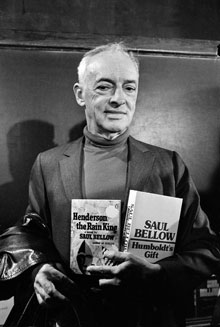 Saul Bellow holding some of his most well-known novels.Photo Credit : Vol1Brooklyn
Saul Bellow holding some of his most well-known novels.Photo Credit : Vol1Brooklyn -
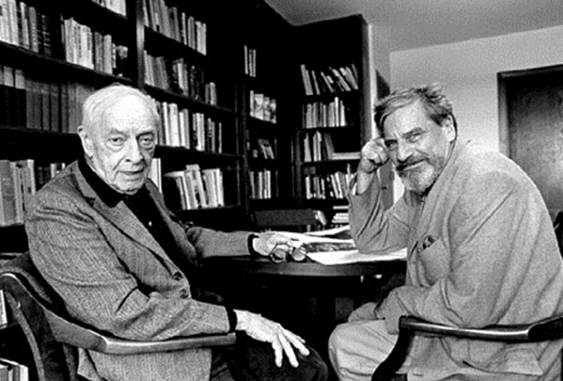 Saul Bellow and Keith Botsford in the 1990's, at Boston University.Photo Credit : Keith Botsford
Saul Bellow and Keith Botsford in the 1990's, at Boston University.Photo Credit : Keith Botsford -
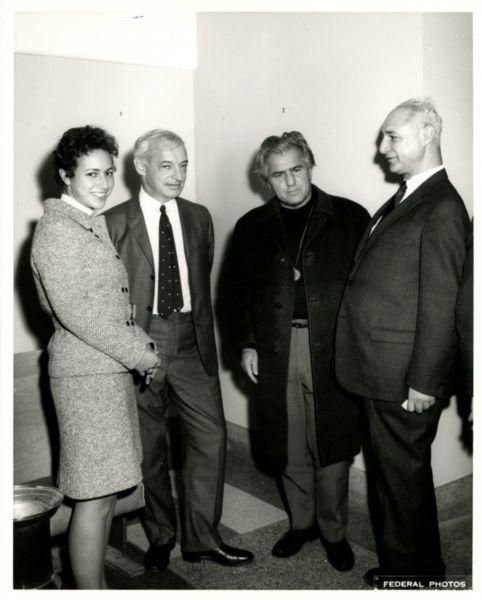 Tibi Rome, Saul Bellow, Irving Layton, and David Rome during Saul Bellow's visit to the Jewish Public Library in 1968.Photo Credit : Jewish Public Library - Archives
Tibi Rome, Saul Bellow, Irving Layton, and David Rome during Saul Bellow's visit to the Jewish Public Library in 1968.Photo Credit : Jewish Public Library - Archives -
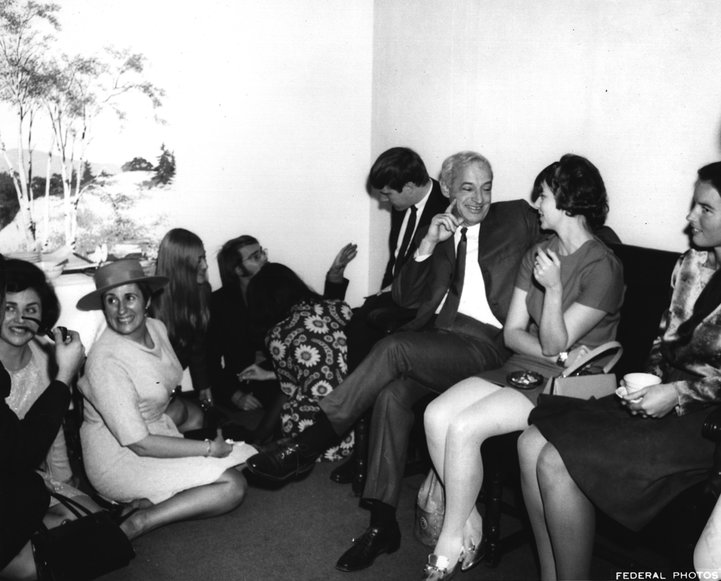 Saul Bellow at George Williams University, with English Department students.Photo Credit : Alex Dworkin Canadian Jewish Archives
Saul Bellow at George Williams University, with English Department students.Photo Credit : Alex Dworkin Canadian Jewish Archives
Saul Bellow
Saul Bellow was a Nobel Prize-winning Canadian-American novelist.
Born Solomon Bellows in Lachine, Quebec, two years after his Lithuanian-Jewish parents emigrated from Saint Petersburg, Russia, Bellows would go on to become one of the most influential writers of the 20th century. At nine, his family moved to the West Side of Chicago, which became the inspiration for much of his work. Rebelling against his mother’s wishes for him to become a rabbi or a concert pianist, Bellow pursued a career in writing.
Bellow studied Sociology and Anthropology and, during the Second World War, he served in the merchant marine, during which time he wrote his first novel. In 1948, he received a Guggenheim Fellowship, which he used to support himself in Paris while writing. Returning to the US, Bellows taught at Yale University, the University of Minnesota, New York University, Princeton University, University of Puerto Rico, University of Chicago, Bard College and Boston University.
Bellow won the Nobel Prize for Literature in 1976 for Humboldt’s Gift. He also received the Pulitzer Prize and the National Medal of Arts. He is the only writer to win the National Book Award for Fiction three times and, in 1990, he received the National Book Foundation’s lifetime Medal for Distinguished Contribution to American Letters.
Bellow was married five times, all but the last ending in divorce, and he fathered his fourth child at age 84.
Learn More:
https://en.wikipedia.org/wiki/Saul_Bellow
https://www.theguardian.com/books/2015/apr/17/the-five-essential-saul-bellow-novels
http://www.nobelprize.org/nobel_prizes/literature/laureates/1976/bellow-bio.html
http://www.newyorker.com/magazine/2015/05/11/young-saulhttp://www.biography.com/people/saul-bellow-9206329
https://www.theguardian.com/books/2015/apr/17/i-got-a-scheme-the-moment-saul-bellow-found-his-voice
http://www.vanityfair.com/culture/2015/04/saul-bellow-biography-zachary-leader-martin-amis

-
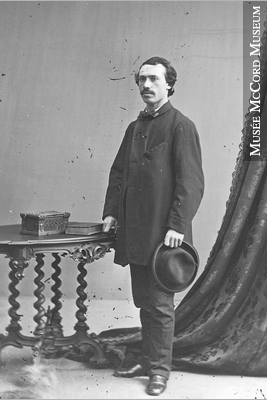 William Raphael, Montreal, 1862.Photo Credit : © McCord Museum
William Raphael, Montreal, 1862.Photo Credit : © McCord Museum
William Raphael
Prussian-born Montrealer William Raphael, known for his portraiture and genre painting, is considered to be the first professional Jewish artist to practice in Canada.
Raphael was born into an Orthodox Jewish family of Polish decent, the Rafalskys, one of at least seven children. In his youth, he made frequent trips between his hometown, Nakel, and Berlin, where he studied at the Academy of Arts. He was strongly influenced by his teachers Karl Begas, a genre/historical scene painter, and Johann Eduard Wolff, a portraitist.
Raphael quit his studies in 1956, when his father got sick. After his father’s death, Raphael decided to immigrate to North America. He arrived in New York City in 1856 and stayed there for four months. Then, in 1857, he moved to Montreal, where one of his brothers was, and stayed there for the rest of his life.
Raphael was well known for his portraits, including many prominent Canadian figures like Dr. Louis- Édouard Desjardins, Dr. Aaron Hart David and the Rev. Abraham de Sola (who performed his marriage). His portraits of Governor Generals were said to have hung in the Parliament Buildings in Ottawa. Raphael was also noted for his lively landscapes, which depicted the lives of aboriginals and French Canadian settlers. One of his most famous paintings is Immigrants at Montreal (later changed to Behind Bonsecours Market, Montreal), which shows the painter in a bustling market scene, with luggage in one hand and a candelabra in the other; it now hangs in the National Gallery of Canada.
To support his art, Raphael taught at both English (the High School of Montreal and the Art Association of Montreal) and French institutions (the Sisters of St. Anne in Lachine and their associated convents), even setting up his own private school for drawing and painting in 1885. The other significant part of his income came from commissioned portraits. He also worked at a photography studio, restored paintings for churches and convents, and was an anatomical illustrator for medical journals and physicians’ teaching aids.
Raphael was active in many professional organizations, such as the Art Association of Montreal, the Ontario Society of Artists, the Pen and Pencil Club of Montreal, and the Council of Arts and Manufacturers of the Province of Quebec. He was a founding member of the Society of Canadian Artists and a charter member of the Royal Canadian Academy of Arts. He was invested as a freemason in 1864. He was also a charter member of Temple Emanu-El in Montreal in 1882.
Raphael married Ernestina Danziger in 1865. They had nine children. One of them, their son Samuel, went on to become a professional artist in NYC.

-
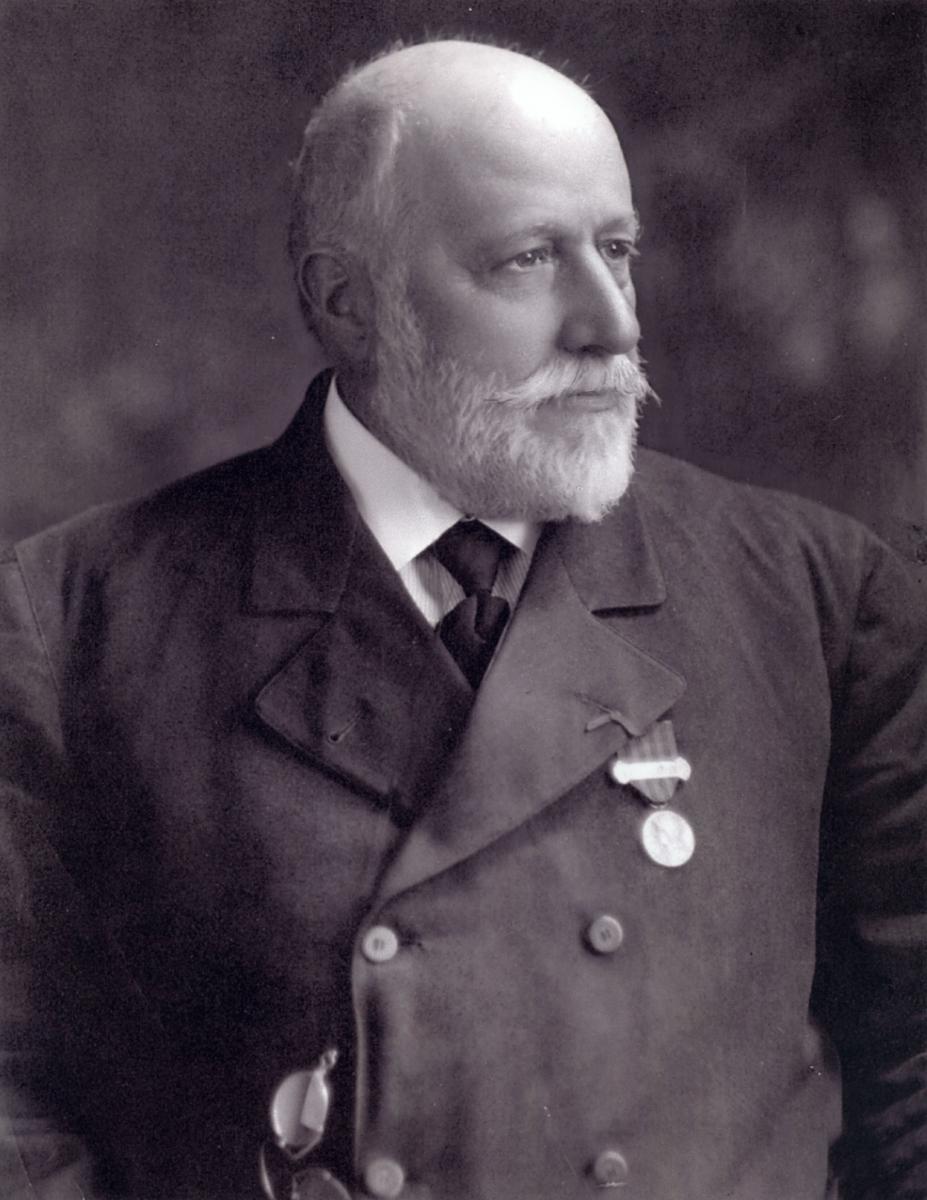 Jules Helbronner.Photo Credit : Source unknown
Jules Helbronner.Photo Credit : Source unknown -
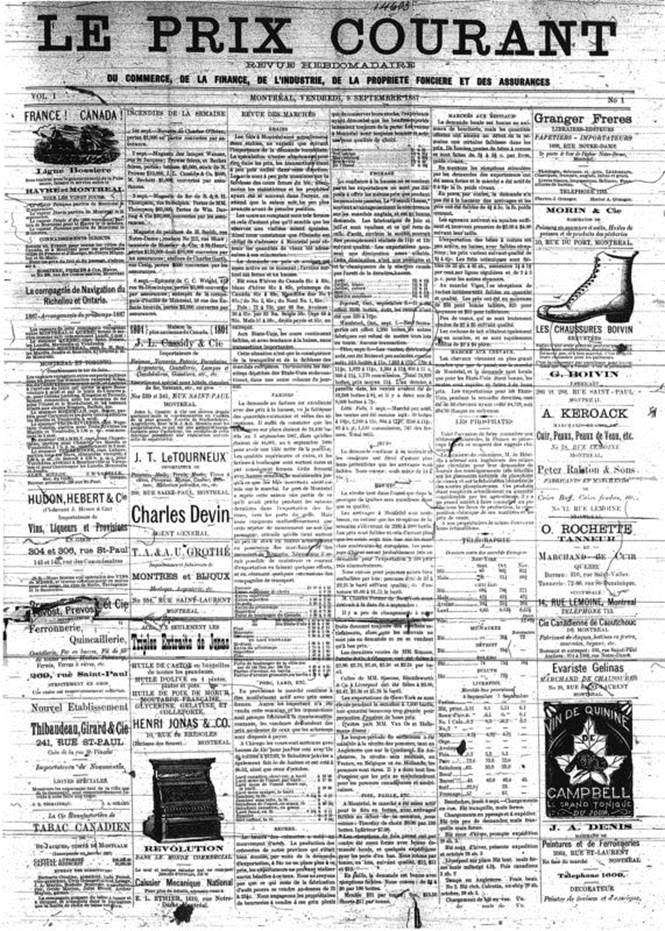 Le prix courant: Vol. 1, no 1 (9 sept. 1887). Included is an article written by Jules Helbronner.Photo Credit : Early Canada Online
Le prix courant: Vol. 1, no 1 (9 sept. 1887). Included is an article written by Jules Helbronner.Photo Credit : Early Canada Online -

-
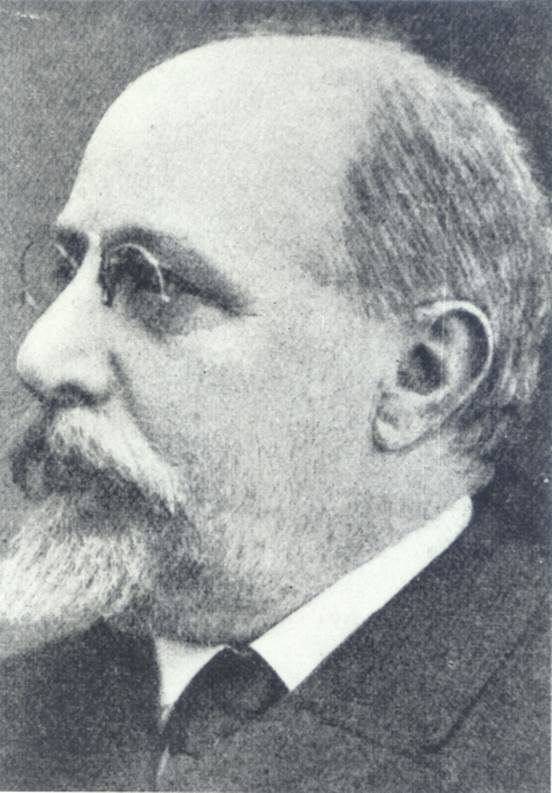 Jules HelbronnerPhoto Credit : Alex Dworkin Canadian Jewish Archives
Jules HelbronnerPhoto Credit : Alex Dworkin Canadian Jewish Archives
Jules Helbronner
An Alsatian Jew who immigrated to Canada in 1874, Jules Helbronner was a prominent figure in Quebec’s French-language community and editor-in-chief of La Presse.
Helbronner embarked on a career in journalism, starting at Le Journal d’Arthabask, then joining the weekly Le Moniteur du commerce in 1882, and becoming its editor-in-chief two years later. During this time, he developed a growing interest in the labour movement and began a sporadic column in La Presse (a daily newspaper focused on municipal affairs and labour) under the pseudonym Jean-Baptiste Gagnepetit. His condemnation of the “corvée,” a regressive fiscal measure imposed on Montreal tenants, helped lead to its elimination in 1886. From 1892 to 1908, Helbronner exerted great influence as editor-in-chief of La Presse, and then joined the team of the paper La Patrie.
A social reformer, Helbronner advocated for change both on and off the page. In the context of increasing industrialisation, he supported labour organizations while also promoting political action and social justice. In 1885, he himself became a member of the Knights of Labor, as well as an executive member of the Central Trades and Labor Council of Montreal. He also participated in the French Chamber of Commerce in Montreal (1887-1905), the National French Union (1901-1909) and the Royal Commission on the Relations of Labor and Capital.
An assimilated Jew of considerable influence, Helbronner also spoke out against the rise of anti-Semitism at a time when few Jews openly opposed it. Though most closely associated with Montreal’s French-language community, Helbronner remained proud of his Jewish cultural heritage, and strongly condemned various manifestations of anti-Semitism around the world, including the Dreyfus affair in the 1890s.
In 1906, he was made a Knight of the Legion of Honour.
Special thanks to the Museum of Jewish Montreal.
Learn more:
http://mimj.ca/location/1068
http://www.cjhn.ca/permalinkFR/191
http://www.lapresse.ca/

-
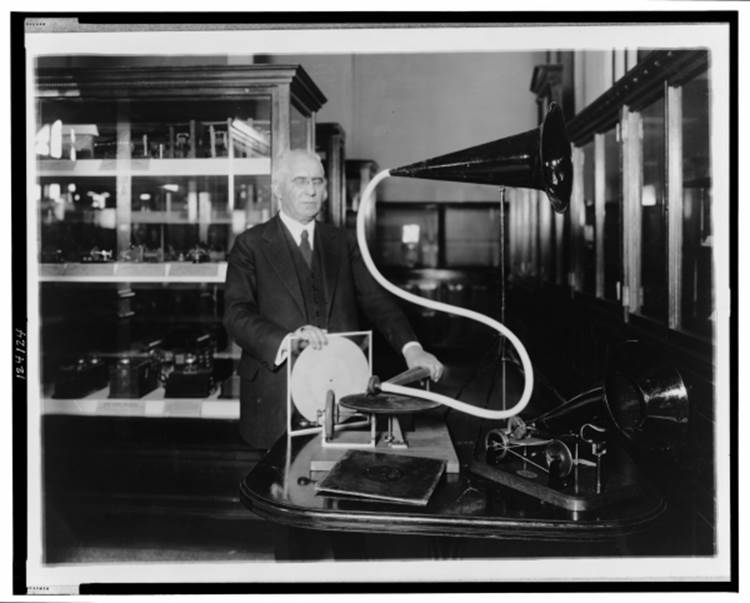 Emile Berliner, with the model of the first phonograph machine which he invented.Photo Credit : Library of Congress. Motion Picture, Broadcasting and Recorded Sounds Division. Washington, D. C.
Emile Berliner, with the model of the first phonograph machine which he invented.Photo Credit : Library of Congress. Motion Picture, Broadcasting and Recorded Sounds Division. Washington, D. C. -
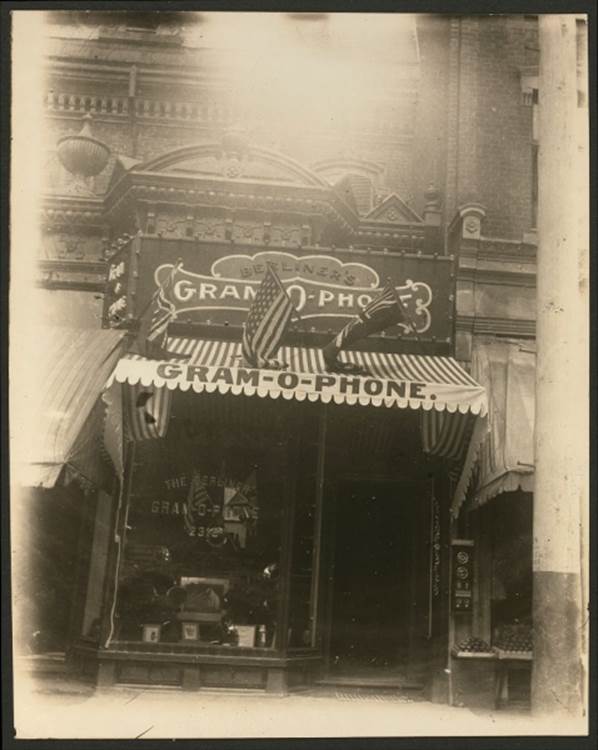 Berliner's Gram-o-phone shop, 2315-2316 St. Catherine Street, Montreal, Canada, ca. 1910.Photo Credit : Library of Congress. Motion Picture, Broadcasting and Recorded Sounds Division. Washington, D. C.
Berliner's Gram-o-phone shop, 2315-2316 St. Catherine Street, Montreal, Canada, ca. 1910.Photo Credit : Library of Congress. Motion Picture, Broadcasting and Recorded Sounds Division. Washington, D. C. -
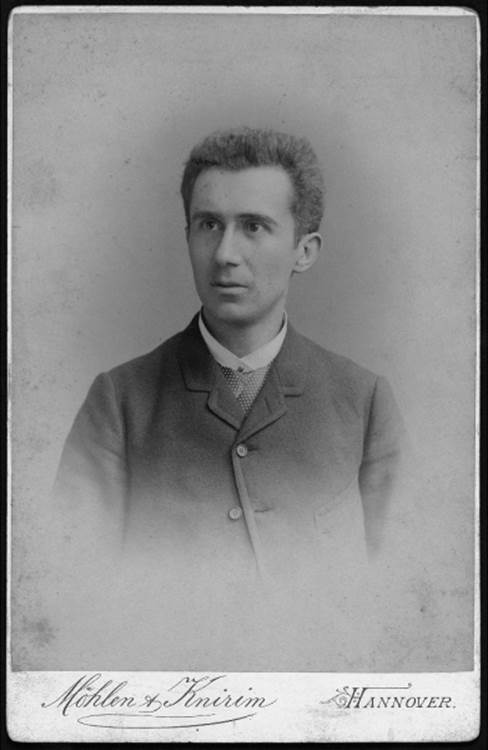 Portrait of Emile Berliner as a young man. Hannover, Germany: Mhlen & Knirm, ca. 1871-1881.Photo Credit : Library of Congress. Motion Picture, Broadcasting and Recorded Sounds Division. Washington, D. C.
Portrait of Emile Berliner as a young man. Hannover, Germany: Mhlen & Knirm, ca. 1871-1881.Photo Credit : Library of Congress. Motion Picture, Broadcasting and Recorded Sounds Division. Washington, D. C. -
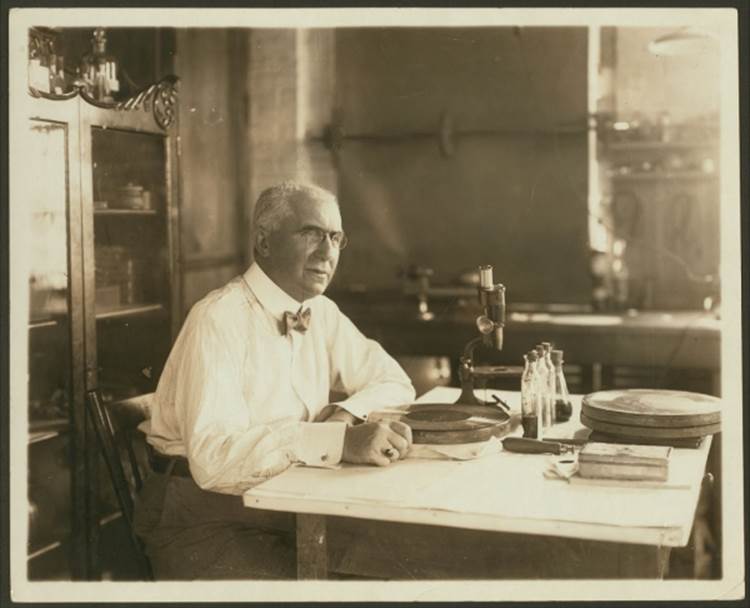 Emile Berliner in laboratory working on disc,, ca. 1910Photo Credit : Library of Congress. Motion Picture, Broadcasting and Recorded Sounds Division. Washington, D. C.
Emile Berliner in laboratory working on disc,, ca. 1910Photo Credit : Library of Congress. Motion Picture, Broadcasting and Recorded Sounds Division. Washington, D. C. -
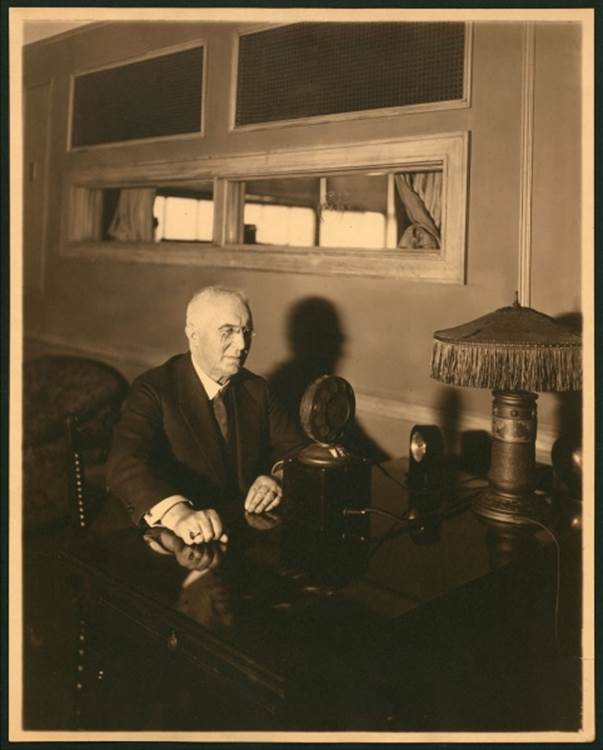 Emile Berliner, seated in front of early microphone, ca. 1920Photo Credit : Library of Congress. Motion Picture, Broadcasting and Recorded Sound Division. Washington, D. C.
Emile Berliner, seated in front of early microphone, ca. 1920Photo Credit : Library of Congress. Motion Picture, Broadcasting and Recorded Sound Division. Washington, D. C. -
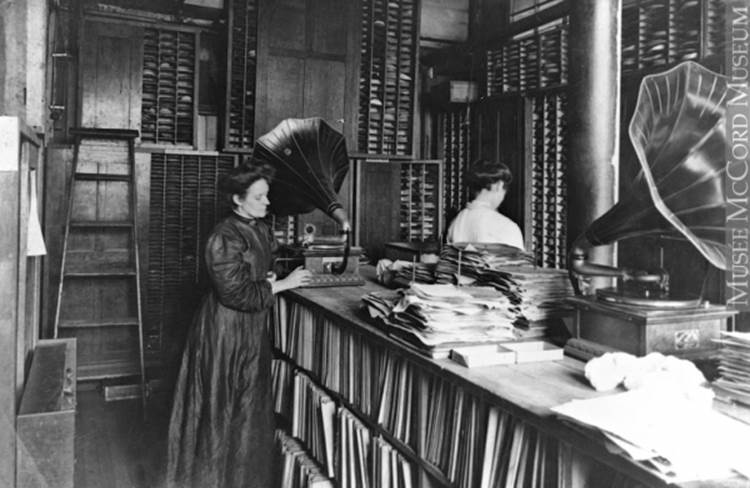 Record Matrix Room, Berliner Gramophone Company, Montreal, QC, 1910.Photo Credit : McCord Museum
Record Matrix Room, Berliner Gramophone Company, Montreal, QC, 1910.Photo Credit : McCord Museum -
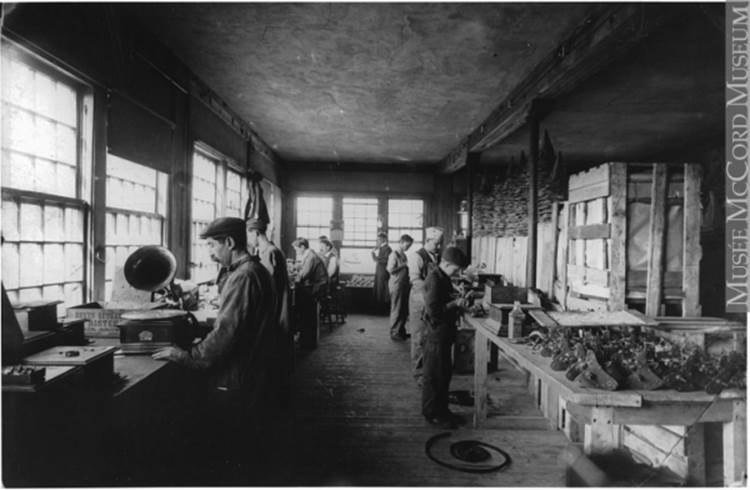 Gramophone Assembling Room, Berliner Gramophone Co., Montreal, QC, 1910Photo Credit : McCord Museum
Gramophone Assembling Room, Berliner Gramophone Co., Montreal, QC, 1910Photo Credit : McCord Museum -
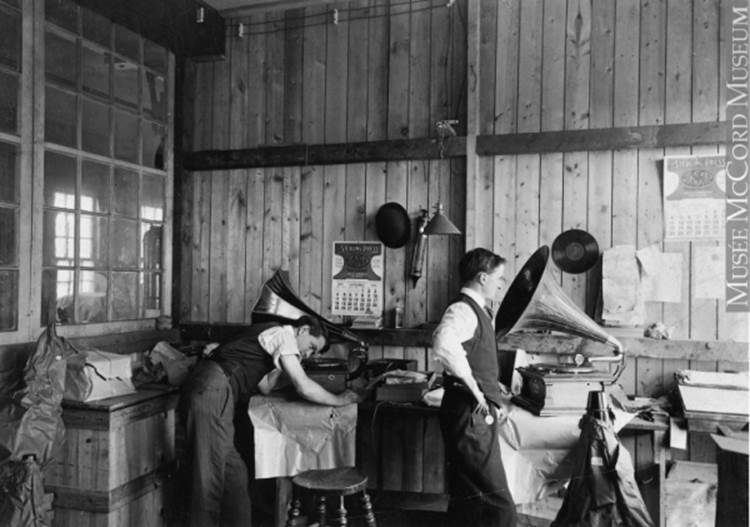 Testing machines, Berliner Gramophone Company, Montreal, QC, 1910.Photo Credit : McCord Museum
Testing machines, Berliner Gramophone Company, Montreal, QC, 1910.Photo Credit : McCord Museum -
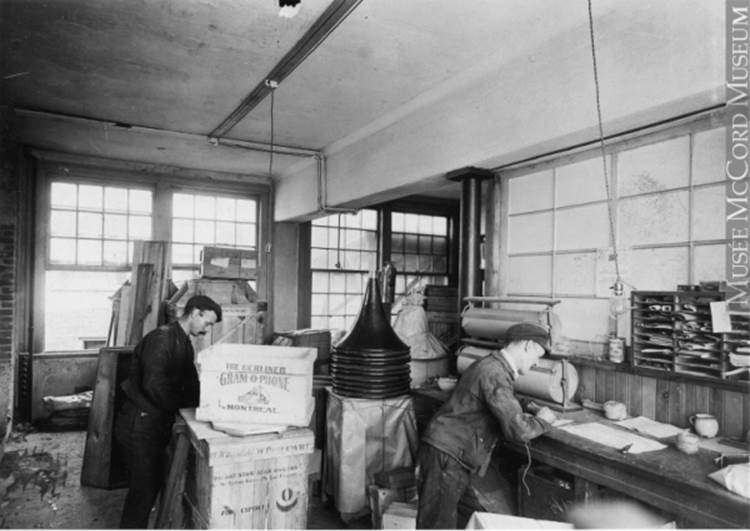 Shipping room, Berliner Gramophone Co., Montreal, QC, 1910Photo Credit : McCord Museum
Shipping room, Berliner Gramophone Co., Montreal, QC, 1910Photo Credit : McCord Museum -
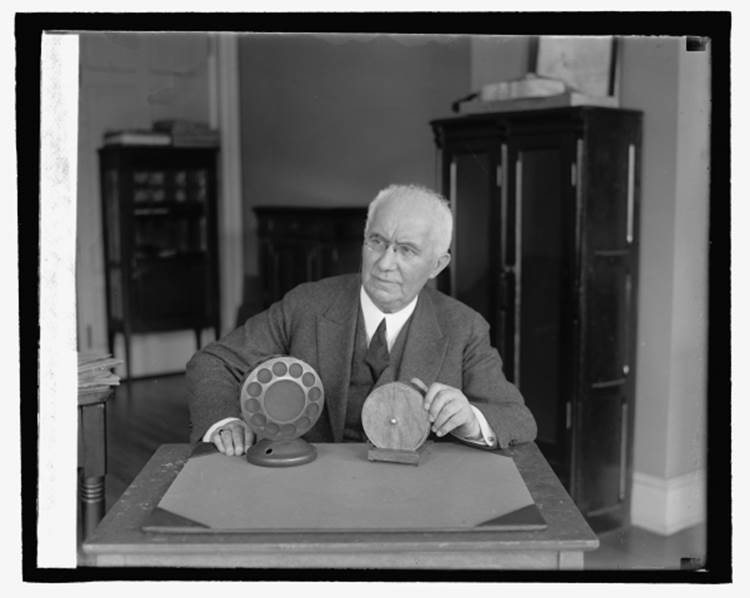 Emile Berliner, 4/12/27.Photo Credit : Courtesy of Library of Congress Prints and Photographs Division Washington, D.C.
Emile Berliner, 4/12/27.Photo Credit : Courtesy of Library of Congress Prints and Photographs Division Washington, D.C. -
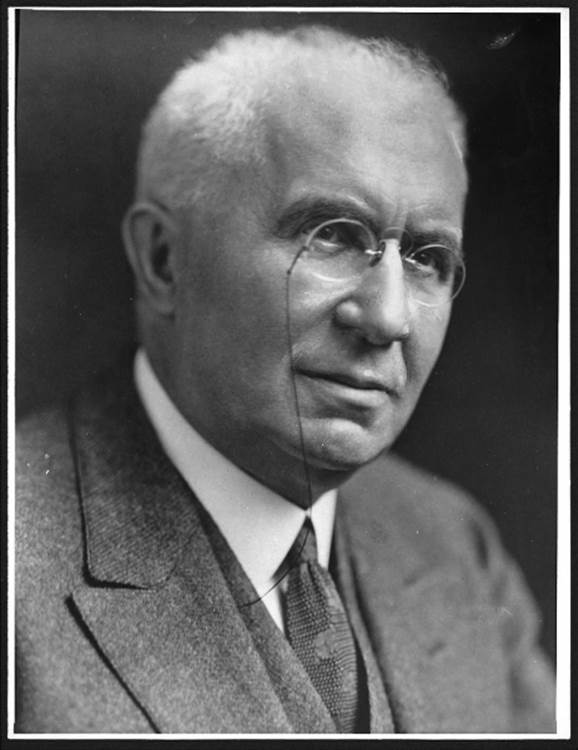 Portrait of Emile Berliner in later years, ca. 1920sPhoto Credit : Broadcasting and Recorded Sound Division. Washington, D. C.
Portrait of Emile Berliner in later years, ca. 1920sPhoto Credit : Broadcasting and Recorded Sound Division. Washington, D. C.
Emile Berliner
Emile Berliner was the inventor of the gramophone and the carbon-button microphone, and his business, Berliner Gram-O-Phone, was the precursor to modern record labels including Universal Music Group, EMI and Sony Music Group.
Emile Berliner was born in Hanover, Germany. Son of a Talmudic scholar, Berliner worked odd jobs after completing public school in 1865. In 1870, he accepted a position with a dry-goods company called Behrend, requiring him to immigrate to the United States. While working for that company, Berliner witnessed Alexander Graham Bell’s demonstration of the telephone at the 1876 Centennial Exhibition in Philadelphia. He immediately began to study the possibilities and shortcomings of Bell’s invention, and invented a new transmitter in 1878, improving upon Bell’s design. Thomas Watson from the American Bell Telephone Company immediately offered Berliner a job as a research assistant.
Berliner worked for the American Bell Telephone Company until 1883, when he moved from Boston to Washington, D.C., to embark on new research. In 1887, the year widely considered to mark the beginning of the record industry, Berliner embarked on his greatest invention, the gramophone. The Imperial Patent Office, proclaiming his invention superior to that of Edison’s cylinder phonograph, honoured Berliner for his achievement in 1890. After conflicts with his associates over the exclusivity of sales rights, Berliner was obliged to cease selling his product in the United States, and came to Montreal at the beginning of the 1900s. He established the Berliner Gram-O-Phone Company in St-Henri in 1908, and expanded his business on the same street block in 1912. This company was the precursor to many major record labels, such as RCA-Victor, Deutsche Grammophon, Universal Music Group, EMI and Sony Music Group. Berliner stayed at the head of the company until 1924, when it was purchased by the Victor Talking Machine. Berliner’s sons, Herbert and Edgar, were involved in the Montreal recording industry in the 1920s and 1930s, including the emerging Francophone market at that time. In fact, La Bolduc, a pioneer of Quebecois folk music, made her first recording in 1929 with Herbert’s company.
Berliner was also involved in social and community affairs. His main focus was public health, especially that of children, and he supported efforts for cleaner milk. Berliner was an ardent defender of women’s equality, a talented composer and musician, and was deeply interested in aeronautics. In 1907, he even invented a helicopter prototype. He was an active Zionist and wrote countless articles and letters between 1913 and 1919, calling for a Jewish home in Palestine. He never lived permanently in Montreal, but often visited the city to manage his business.
Special thanks to the Museum of Jewish Montreal.
Learn More:
http://imjm.ca/location/1564
http://mimj.ca/location/1749
http://moeb.ca/en/emile-berliner
http://studiovictor.ca/en/hystory/
http://www.ameriquefrancaise.org/en/article-298/first_recordings_of_popular_songs_in_french_canada.html
https://memory.loc.gov/ammem/berlhtml/berlemil.html

-
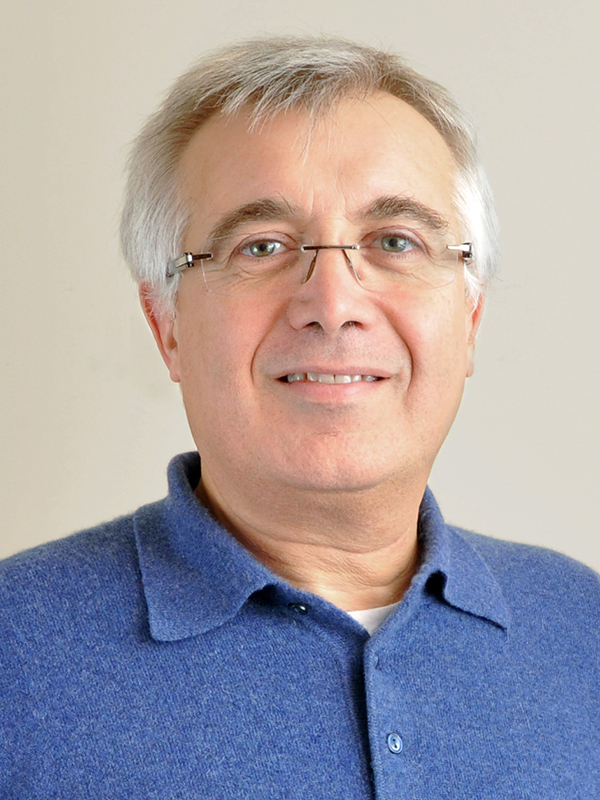 Dr. Eric Cohen.Photo Credit : Canadian Institutes of Health Research
Dr. Eric Cohen.Photo Credit : Canadian Institutes of Health Research
Dr. Eric Cohen
Through their research, Dr. Eric Cohen and his team have helped significantly advance research for an HIV/AIDS cure.
As Director of the Human Retrovirology Research Unit and of the Immunity and Viral Infections Research Division at the Montreal Clinical Research Institute (IRCM), Cohen was one of the first Canadian scientists to study HIV. His postdoctoral work identified two viral proteins which play a key role in the spreading and multiplication of the virus: Vpu and Vpr.
Born in Morocco, Cohen holds a PhD in Molecular Biology from Université de Montréal. He pursued his postdoctoral studies at the renowned Dana-Farber Cancer Institute, affiliated with Harvard Medical School.
Before joining the IRCM, he ran a lab specializing in the molecular biology of HIV within the Department of Microbiology and Immunology at Université de Montréal, where he is currently a Full Professor. Cohen is also Adjunct Professor in the Department of Medicine (Division of Experimental Medicine) at McGill University. He has earned the title of Canada Research Chair in Human Retrovirology.
In 2007, Cohen and his team published the results of a breakthrough, opening the door to a new category of HIV medication. The study appeared in PLOS Pathogens, a prestigious online American scientific journal which is edited by the Public Library of Science. The team uncovered a cellular protein complex targeted by the HIV-1 Pvr protein, capable of halting the division of cells infected by the HIV virus.
In 2012, Cohen received the Marcel-Piché Prize, one of the highest honours awarded in the field of scientific research in Quebec and Canada.
Cohen is a member of the Canadian Academy of Health Sciences and the Royal Society of Canada.

-
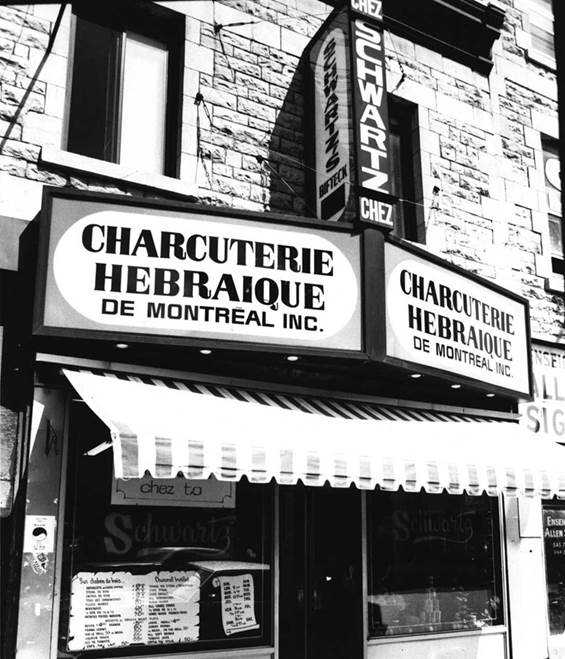 Schwartz's Deli - St. Lawrence Blvd., Montreal.Photo Credit : Alex Dworkin Canadian Jewish Archives
Schwartz's Deli - St. Lawrence Blvd., Montreal.Photo Credit : Alex Dworkin Canadian Jewish Archives -
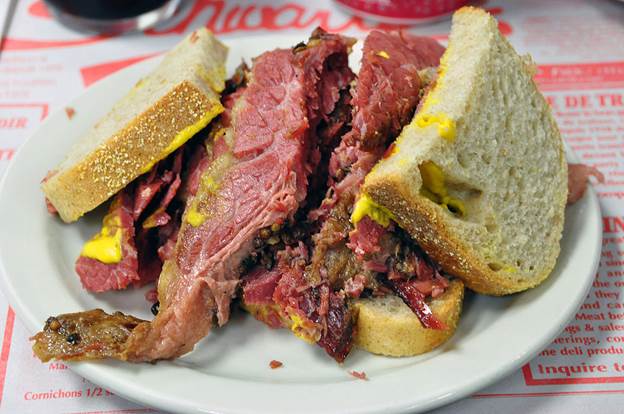 Schwartz's smoked meat, medium fat, Montreal, 2010.Photo Credit : Chensiyuan
Schwartz's smoked meat, medium fat, Montreal, 2010.Photo Credit : Chensiyuan -
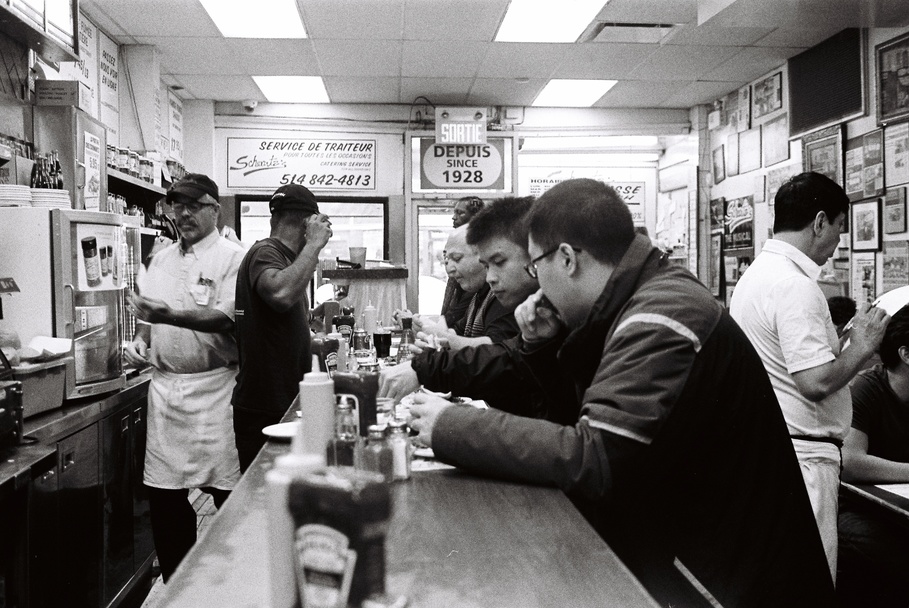 Schwartz's.Photo Credit : Oh God! Oh Montreal! Travelling with Mordechai Richler, Andrea Paolella
Schwartz's.Photo Credit : Oh God! Oh Montreal! Travelling with Mordechai Richler, Andrea Paolella -
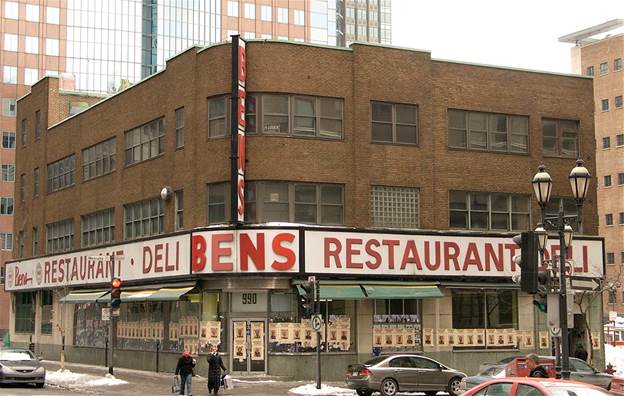 Bens De Luxe Delicatessen & Restaurant, Montreal, 2007.Photo Credit : Michael Stanton
Bens De Luxe Delicatessen & Restaurant, Montreal, 2007.Photo Credit : Michael Stanton -
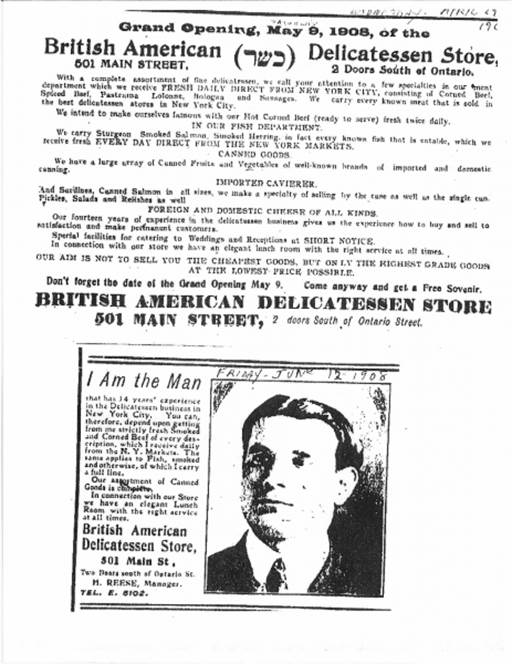 Advertisement for H. Rees British American Delicatessen, most likely the first sit-down deli to sell smoked meat in Montreal, in the Jewish Times, Wednesday, April 29, 1908.Photo Credit : Jewish Public Library - Archives
Advertisement for H. Rees British American Delicatessen, most likely the first sit-down deli to sell smoked meat in Montreal, in the Jewish Times, Wednesday, April 29, 1908.Photo Credit : Jewish Public Library - Archives -
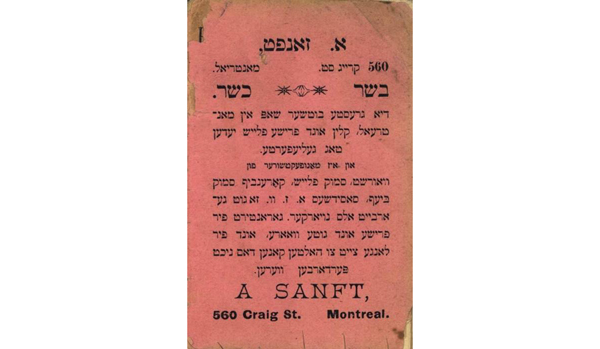 Advertisement in an 1894 Yiddish-language almanac/calendar issued by Ogilvy's. The ad is for Aaron Sanft, a butcher on Craig Street, who was most likely the first purveyor of Jewish smoked meat in Montreal.Photo Credit : Alex Dworkin Canadian Jewish Archives
Advertisement in an 1894 Yiddish-language almanac/calendar issued by Ogilvy's. The ad is for Aaron Sanft, a butcher on Craig Street, who was most likely the first purveyor of Jewish smoked meat in Montreal.Photo Credit : Alex Dworkin Canadian Jewish Archives -
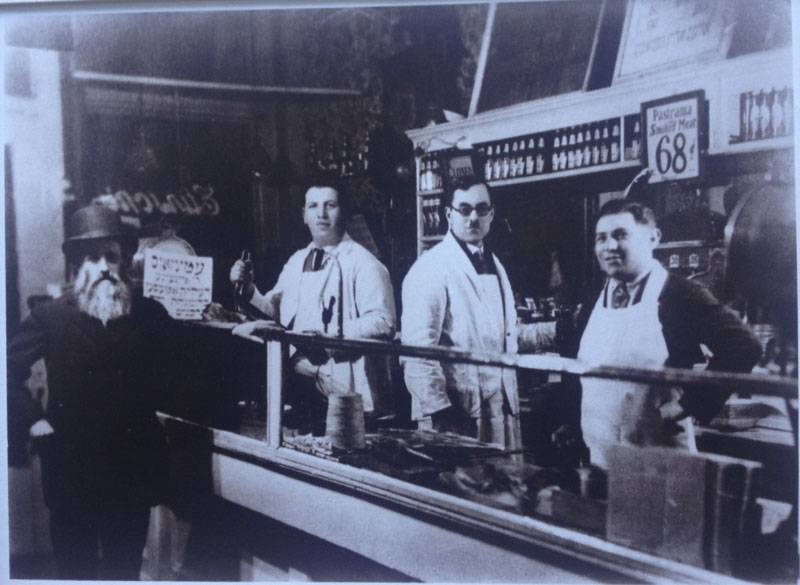 According to family stories, Aaron Etinson arrived in Montreal from Romania prior to World War I in possession of a secret recipe for smoking meats. He opened the store in 1918.Photo Credit : Michael Etinson/Debby Newpol
According to family stories, Aaron Etinson arrived in Montreal from Romania prior to World War I in possession of a secret recipe for smoking meats. He opened the store in 1918.Photo Credit : Michael Etinson/Debby Newpol
Smoked Meat
Along with bagels and poutine, many identify Montreal’s smoked meat (beef brisket enhanced by spices and Eastern European-influenced smoking methods) as emblematic of the city’s cuisine, and the question of which delicatessen introduced the first and best smoked meat sandwich has long been debated along the Main.
Bens, which opened in 1911, claimed to be Montreal’s first delicatessen. Catering to factory workers at their fruit store on St. Lawrence and Duluth, Ben and Fanny Kravitz expanded their repertoire to include smoked meat sandwiches, using Lithuanian techniques. In 1925, the store was renamed B. Kravitz Delicatessen (also known as Bens de Luxe Delicatessen Sandwich Shop) before moving to Burnside Street (now de Maisonneuve), where it remained until 2006, when it closed due to a labour dispute.
While Kravitz promoted himself as having introduced smoked meat to Montreal, Lovell’s Directory and newspaper ads reveal that Hyman Rees’ British-American Delicatessen Store (on St. Lawrence near Ontario) was actually dispensing smoked meat sandwiches in 1908, a few years prior to the establishment of Fanny’s Fruit and Candy Store. While Rees’ was the first sit-down delicatessen to sell smoked meat, a series of butchers were preparing smoked meat as early as the 1890s. Aaron Sanft, a butcher on Craig Street (now St-Antoine), was perhaps the first. Using a Romanian recipe, he advertised his American Sausage Factory’s smoked meat in an 1894 Jewish calendar.
Another contender for Montreal’s smoked meat fame is the Montreal Hebrew Delicatessen, popularly known as Schwartz’s. Established in 1927 on St. Lawrence near Napoléon, and employing Romanian smoking techniques, the original owner, Reuben Schwartz, was forced to sell the business in 1932 due to his gambling and womanizing. The new owner, a musician named Maurice Zbriger, was reluctant to have his name affiliated with a “pedestrian eatery” and rehired Schwartz as his manager to front for him.
With the closing of Bens, many label Schwartz’s as the undisputed king of Montreal delis (although its competitors across the street at the Main Deli, as well as at Lester’s, Dunn’s and the Snowdon Deli would argue otherwise). The history of Schwartz’s is commemorated in Garry Beitel’s film, Chez Schwartz’s and Bowser & Blue’s Schwartz’s: The Musical.
According to Eiran Harris, the Jewish Public Library’s Archivist Emeritus, as smoked meat sandwiches gained an international culinary reputation, Jewish delicatessens expanded from four at the turn of the century to 45 in 1932. A number of these lesser-known delis prepared their own smoked meat, including Etinson’s, Rogatco’s, Chenoy’s, Hebrew National, Putter’s, Shagass’s, Levitt’s and Montreal’s Palestine Salami Factory. Today, few Jewish-style sit-down delis remain in Montreal, and none are under rabbinical supervision. However, they remain culinary landmarks, and popular tourist attractions.
Special thanks to the Museum of Jewish Montreal.
Learn More:
http://thecanadianencyclopedia.com/en/article/maurice-zbriger-emc/
http://www.theglobeandmail.com/arts/theatre-and-performance/schwartzs-the-musical-do-you-want-it-on-rye-or-with-the-singing-pickle/article574477/
http://www.mtlblog.com/2016/05/the-real-story-behind-schwartzs-deli/#
http://imjm.ca/location/2363
https://soundcloud.com/iciradiocanadapremiere/la-viande-fumee-daaron-sanft-cest-pas-trop-tot
http://www.erudit.org/revue/cuizine/2009/v1/n2/037859ar.html

-
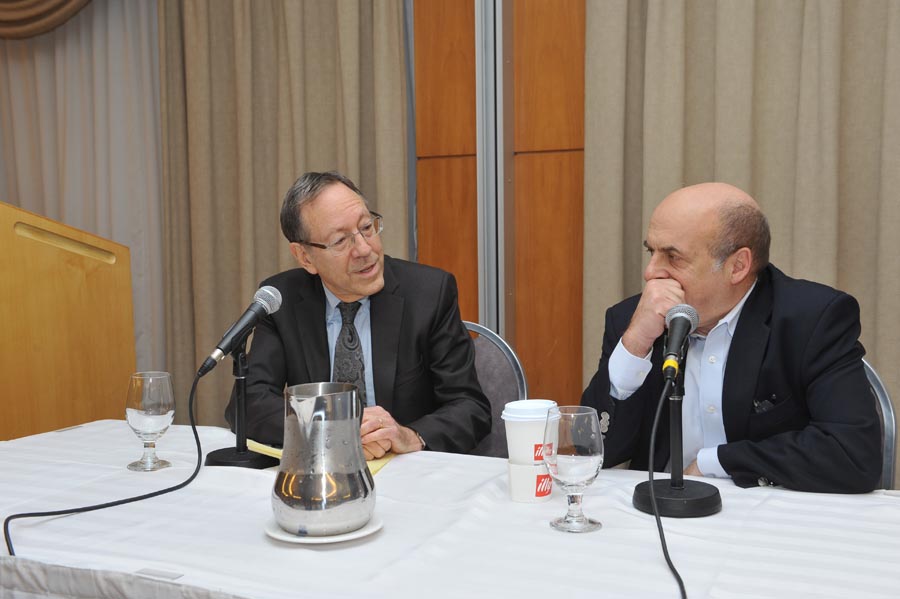
-
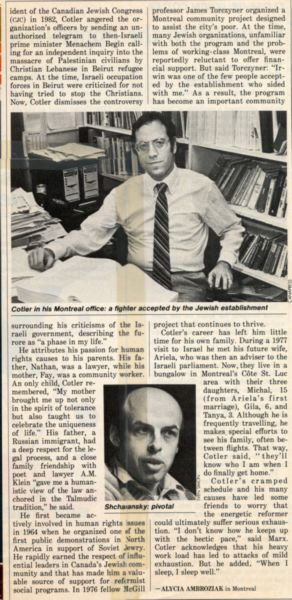 Newsclipping about Irwin Cotler from Macleans Magazine describing his devotion to the Jewish community in Montreal.Photo Credit : Jewish Public Library - Archives
Newsclipping about Irwin Cotler from Macleans Magazine describing his devotion to the Jewish community in Montreal.Photo Credit : Jewish Public Library - Archives -
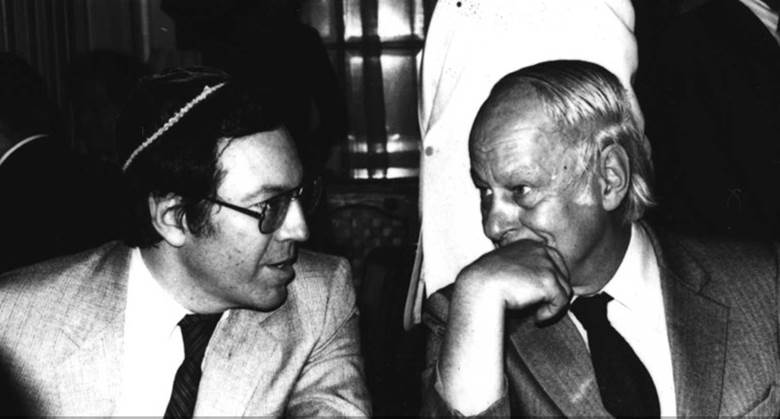 Irwin Cotler and Premier Réné Lévesque, 1982.Photo Credit : Alex Dworkin Canadian Jewish Archives
Irwin Cotler and Premier Réné Lévesque, 1982.Photo Credit : Alex Dworkin Canadian Jewish Archives -
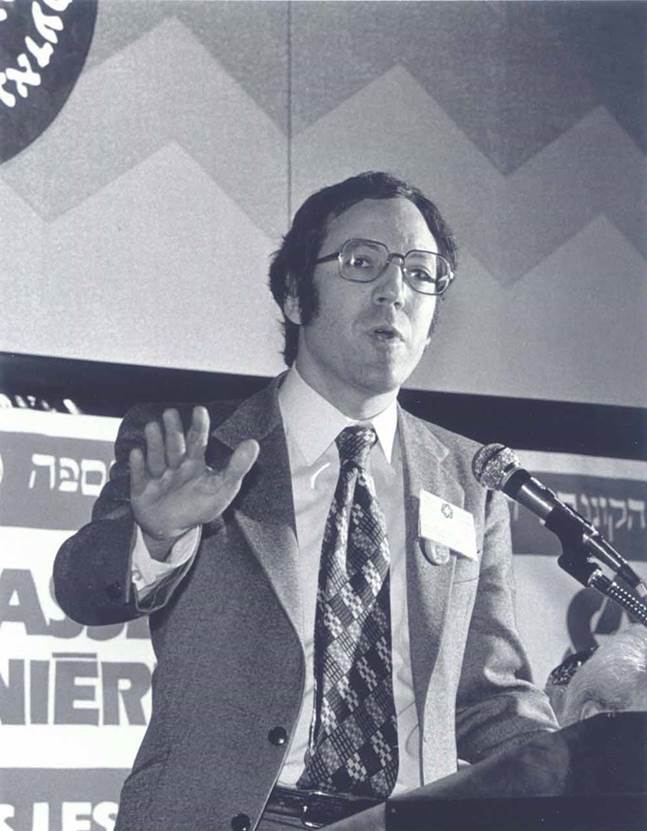 Irwin Cotler.Photo Credit : Alex Dworkin Canadian Jewish Archives
Irwin Cotler.Photo Credit : Alex Dworkin Canadian Jewish Archives -
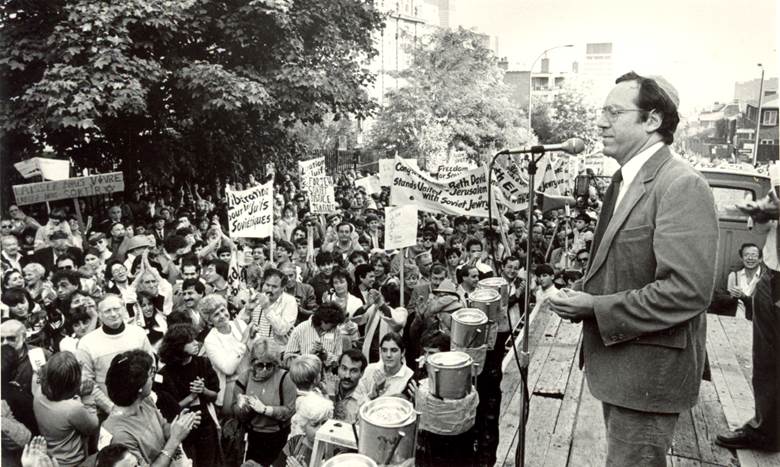 Irwin Cotler speaking at a Soviet Jewry demonstration at Russian Embassy, 1985.Photo Credit : Alex Dworkin Canadian Jewish Archives
Irwin Cotler speaking at a Soviet Jewry demonstration at Russian Embassy, 1985.Photo Credit : Alex Dworkin Canadian Jewish Archives
Irwin Cotler
Irwin Cotler is a Montreal-based human rights lawyer, former Attorney General and Minister of Justice for Canada, who was appointed to the Order of Canada in 1992.
Cotler, the son of a lawyer, received his undergraduate and law degrees at McGill and his Master of Laws from Yale University. He was a professor of law at McGill, where he specialized in human rights and international law, and taught the future NDP-leader, Thomas Mulcair. A tireless defender of civil rights, Cotler has been prominent in many human rights organizations and battles over the decades, including the plight of Soviet Jews, defending international dissidents – such as Nelson Mandela, Jacobo Timerman, Natan Shranasky, Andrei Sakharov and others – and fighting for equal rights for all.
He entered politics in 1999 as a Member of Parliament for Mount-Royal, winning his seat with 92% of the votes in a by-election. He served as Minister of Justice and Attorney General under Prime Minister Paul Martin, from 2003 to 2006, and sat as a Member of Parliament until 2014. While Minister of Justice, he introduced the National Justice Initiative Against Racism, as well as legislation that would lead to equal marriage rights in Canada. During his time in government, he sat on many committees, including Global Affairs, Security & Public Health, Domestic Affairs, Aboriginal Affairs and Canada-US Affairs.
Cotler served as Chief Counsel on the Deschenes Commission investigating War Criminals in Canada. He was also President of the Canadian Jewish Congress.
Learn More:
http://www.theglobeandmail.com/news/politics/veteran-liberal-mp-irwin-cotler-to-retire-from-politics/article16706618/
https://www.youtube.com/watch?v=7tkQMNgcey8
https://irwincotler.liberal.ca/biography/
http://www.raoulwallenbergcentre.org/irwin-cotler/
https://twitter.com/IrwinCotler?ref_src=twsrc%5Egoogle%7Ctwcamp%5Eserp%7Ctwgr%5Eauthor

-
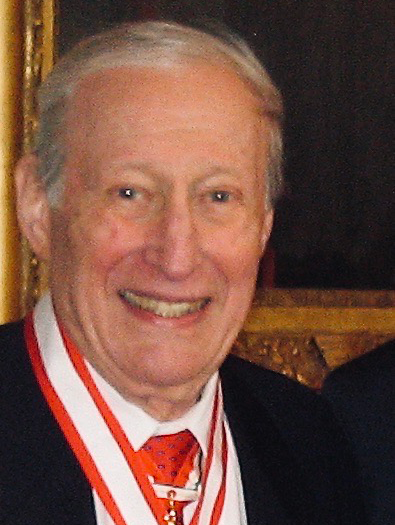 Leon Katz.Photo Credit : Floralove Katz
Leon Katz.Photo Credit : Floralove Katz
Leon Katz
Montreal born Leon Katz was a pioneering biomedical engineer whose work significantly improved patient care and safety throughout Canada.
Katz invented, innovated and hand-crafted a wide range of medical devices: one of the first fetal monitors, a scanner-printer to detect radioactive iodine uptake in the thyroid gland, infant incubators, and a high-speed contrast injector for angiography, etc. He operated these new devices in countless clinical procedures. Notably, using his own original heart-lung bypass machine, he was the perfusionist for Canada’s first successful open heart surgery, and for thousands of subsequent operations.
Katz served as the first chief of the Diagnostic Devices Division and Evaluation and Standards Division in the Bureau of Medical Devices in Ottawa. At Health Canada, he established ground-breaking legislation with regards to medical devices. His team’s discovery of hazards in blood collection led to international recalls of tainted equipment and saved countless lives.
Katz was named an Officer of the Order of Canada, a Member Emeritus of the Canadian Medical and Biological Engineering Society and a Fellow of the Engineering Institute of Canada, which he helped to found. He received the Order of Ontario and the Living Legend Award from the World Society of Cardio-Thoracic Surgeons. He was also a decorated WWII Veteran, who was an officer in the British Army, in the American Zone, and assisted the Jewish Brigade—the only military unit in the Allied forces to serve as an independent, national Jewish military formation.
Katz met his wife, Ruth Gottlieb, when they were both on their way to work on kibbutzim in Israel in 1949. They married in Montreal the following year. Over the course of their 65 year marriage, they had four children: Michael, Geoffrey, Floralove and Shelley.


-
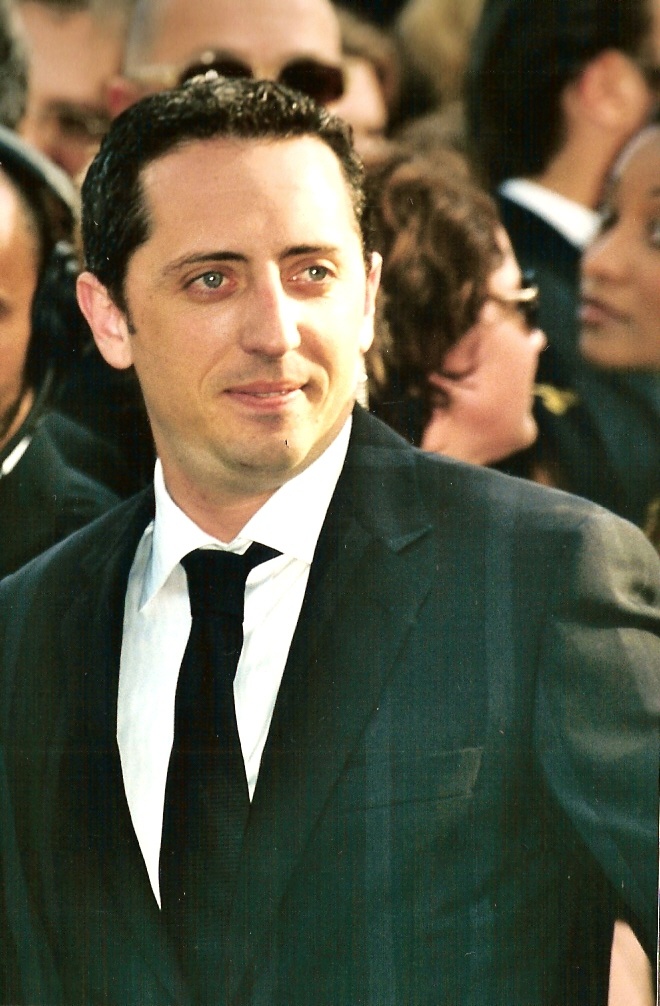 Photo Credit : Georges Biard
Photo Credit : Georges Biard -
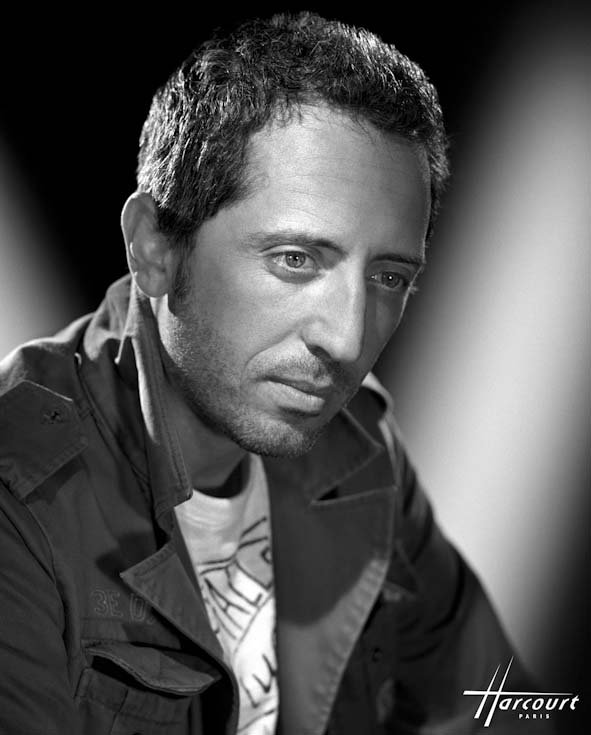 Photo Credit : Studio Harcourt
Photo Credit : Studio Harcourt -
 Photo Credit : S. Camelot (Flickr)
Photo Credit : S. Camelot (Flickr)
Gad Elmaleh
Gad Elmaleh is a Moroccan-born, French Jewish actor and comedian, often referred to as the "Jerry Seinfeld of France."
Born in Casablanca, Elmaleh was born into a theatrical Jewish family. His father was a mime and two of his siblings are actors, a stage director and a singer. He left Morocco in 1988 to study Political Science at McGill University. While a student in Canada, he also worked on radio and comedies. In 1992, he moved to Paris.
In Paris, despite an inconsistent history of schooling, Elmaleh was accepted into the prestigious drama school Cours Florent, where he studied with French actress Isabelle Nanty. There, in 1996, he wrote and performed a one-man show about his experiences in Montreal and Paris, called Décalages. His second one-man show, La vie normale, showed off not only his talent as a scriptwriter, but as an actor. Since that time, he has acted in over 40 roles.
Raised in multilingual Morocco, speaking French, Arabic and Hebrew, Elmaleh has done stand-up in all three languages. He has recently decided to challenge himself to do comedy routines in English and has since relocated to the US. He said that he prepares by practicing English pronunciation every day for two hours.
Learn More:
Public Radio International
Comedians in Cars Getting Coffee with Gad Elmaleh

